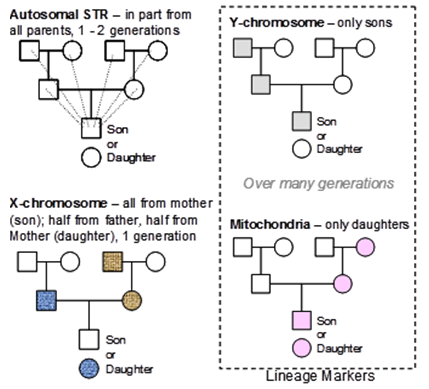| DNA Testing for Relationship > Technology Overview |
 |
Technology Overview
Our DNA testing systems enable us to evaluate most parentage cases
Autosomal Short Tandem Repeats (Au-STR) analysis |
|||
| ● | Human DNA Identification and Relationship Testing |  |
|
| ● |
|
||
| ● |
|
||
Forensic DNA Samples and Aged DNA Samples |
|||
| ● | In-house developed Mini-STR system for DNA profiling of degraded or fragmented DNA samples | ||
Mitochondrial DNA (mtDNA) nucleotide sequencing |
|||
| ● | For tracing maternal ancestry in Grandparentage DNA Test and DNA Maternity Test | ||
| ● | Test whether sharing the same mother with siblings- Siblings DNA Test | ||
| ● | For hair or bone samples that have limited amount of usable genomic DNA | ||
Sex Chromosomal STR analysis (X and Y chromosomes STR) |
|||
| ● | X-Chromosome STR tracing the maternal lineage whether share the same female ancestor or paternal lineage in deficiency case | ||
| ● | Y-Chromosome STR tracing the paternal lineage whether share the same male ancestor | ||
| ● | Used in forensic identification to confirm the gender of suspect | ||
Single Nucleotide Polymorphism (SNP) |
|||
All cells/tissues or objects containing cellular DNA are suitable as samples for DNA testing. Examples that we have handled are listed in each section. Same body, different cellular sources, same DNA, identical results! All biological samples are carefully extracted for DNA by our laboratory staff using commercial and/or GenePro’s lab-developed methods that are customized for handling challenging samples. Extracted DNA will then be: quantified, amplified (STR by PCR) and analyzed by capillary electrophoresis; and/or nucleotide sequencing if needed, followed by interpretation of the results. |
|
DNA Test Protocols
| GenePro’s relationship DNA testing follows the recommendations of international guidelines: |
| ● | International Society of Forensic Genetics (ISFG) [Morling et al 2002, Forensic Sci. Intl. 129:148-157; Gjertson et al 2007, Forensic Sci. Intl.(Genetics)];
. |
|
| ● | American Association of Blood Banks Standards (AABB) [Guideline for Relationship Testing Laboratories 12th Ed., 2015]. | |
| ● | Documented protocols and interpretations in the literature are also used. | |
Reporting and Interpretation
Statement of biological relationship is based on Likelihood Ratio (LR, e.g. Paternity/Kinship Index) that compares contrasting hypotheses mutually exclusive (i.e. Probability of a true relationship / Probability of a false relationship). Calculation is based on a specific population database (𝜃 = 0.01) and the probability (W) is calculated using a prior probability of 50%.
|


